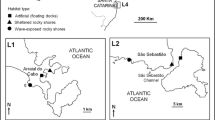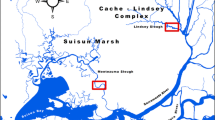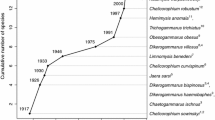Abstract
Invasions of non-native species are modifying global biodiversity but the ecological mechanisms underlying invasion processes are still not well understood. A degree of niche separation of non-native and sympatric native species can possibly explain the success of novel species in their new environment. In this study, we quantified experimentally and in situ the environmental niche space of caridean shrimps (native Crangon crangon and Palaemon adspersus, non-native Palaemon elegans) inhabiting the northern Baltic Sea. Field studies showed that the non-native P. elegans had wider geographical range compared to native species although the level of habitat specialization was similar in both Palaemon species. There were clear differences in shrimp habitat occupancy with P. elegans inhabiting lower salinity areas and more eutrophicated habitats compared to the native species. Consequently, the non-native shrimp has occupied large areas of the northern Baltic Sea that were previously devoid of the native shrimps. Experiments demonstrated that the non-native shrimp had higher affinity to vegetated substrates compared to native species. The study suggests that the abilities of the non-native shrimp to thrive in more stressful habitats (lower salinity, higher eutrophication), that are sub-optimal for native shrimps, plausibly explain the invasion success of P. elegans.






Similar content being viewed by others
References
Aguzzi J, Sbragaglia V, Sarriá D, García JA, Costa C, Río JD, Mànuel A, Sardà F (2011) A new laboratory radio frequency identification (RFID) system for behavioural tracking of marine organisms. Sensors 11:9532–9548
Barnes RSK (1994) The brackish-water fauna of northwestern Europe: an identification guide to brackish-water habitats, ecology and macrofauna for field-workers, naturalists and students. Cambridge University Press, Cambridge, pp 406–411
Bendtsen J, Gustafsson KE, Söderkvist J, Hansen JLS (2009) Ventilation of bottom water in the North Sea-Baltic Sea transition zone. J Mar Syst 75:138–149
Berglund A (1980) Niche differentiation between two littoral prawns in Gullmar Fjord, Sweden: Palaemon adspersus and P. squilla. Ecography 3:111–115
Berglund A (1981) Sex dimorphism and skewed sex ratios in the prawn species Palaemon adspersus and P. squilla. Oikos 36:158–162
Bonsdorff E (2006) Zoobenthic diversity-gradients in the Baltic Sea: continuous post-glacial succession in a stressed ecosystem. J Exp Mar Biol Ecol 330:383–391
Callaway RM, Ridenour WM (2004) Novel weapons: invasive success and the evolution of increased competitive ability. Front Ecol Environ 2:436–443
Castro P, Huber ME (2003) Marine biology, 4th edn. McGraw-Hill, New York, pp 219–221
Clavel J, Julliard R, Devictor V (2011) Worldwide decline of specialist species: toward a global functional homogenization? Front Ecol Environ 9:222–228
Cuesta JA, González-Ortegón E, Rodríguez A, Baldó F, Vilas C, Drake P (2006) The decapod crustacean community of the Guadalquivir Estuary (SW Spain): seasonal and inter-year changes in community structure. Hydrobiologia 557:85–95
Dick JT, Gallagher K, Avlijas S, Clarke HC, Lewis SE, Leung S et al (2013) Ecological impacts of an invasive predator explained and predicted by comparative functional responses. Biol Invasions 5:837–846
Dolédec S, Chessel D, Gimaret-Carpentier C (2000) Niche separation in community analysis: a new method. Ecology 81:2914–2927
Dray S, Dufour AB (2007) The ade4 package: implementing the duality diagram for ecologists. J Stat Softw 22:1–20
Duncan RP, Williams PA (2002) Ecology: Darwin’s naturalization hypothesis challenged. Nature 417:608–609
Elton CS (1927) The nature and origin of soil-polygons in Spitsbergen. Quarterly Journal of the Geological Society 83:163
Elton CS (1958) The ecology of invasions by plants and animals. Methuen, London
Eriksson BK, van Sluis Ch, Sieben K, Kautsky L, Råberg S (2010) Omnivory and grazer functional composition moderate cascading trophic effects in experimental Fucus vesiculosus habitats. Mar Biol 158:747–756
González-Ortegón E, Pascual E, Cuesta JA, Drake P (2006) Field distribution and osmoregulatory capacity of shrimps in a temperate European estuary (SW Spain). Estuar Coast Shelf Sci 67:293–302
Grinnell J (1928) A distributional summation of the ornithology of Lower California. University of California Publications in Zoology 32:1–300
Gruszka P, Więcaszek B (2011) Palaemon elegans Rathke, 1837 in the food of Baltic cod (Gadus morhua callarias L., 1758) from the Gulf of Gdańsk. Mar Biol Res 7:100–105
Guerin AJ, Neil DM (2015) Escape trajectories of the rockpool prawn (Palaemon elegans) in response to visual and mechanosensory stimuli. Mar Freshw Behav Phy 48:145–161
HELCOM (2015) Manual for marine monitoring in the COMBINE programme of HELCOM. http://www.helcom.fi/action-areas/monitoring-and-assessment/manuals-and-guidelines/combine-manual. Accessed February 2016
Herkül K, Lauringson V, Kotta J (2016) Specialization among amphipods: the invasive Gammarus tigrinus has narrower niche space compared to native gammarids. Ecosphere. doi:10.1002/ecs2.1306
Hobbs RJ, Arico S, Aronson J, Baron JS, Bridgewater P, Cramer VA et al (2006) Novel ecosystems: theoretical and management aspects of the new ecological world order. Global Ecol Biogeogr 15:1–7
Hubert WA, Pope KL, Dettmers JM (2012) Passive capture techniques. In: Zale AV, Parrish DL, Sutton TM (eds) Fisheries techniques. American Fisheries Society, Bethesda, pp 223–265
Janas U, Baranska A (2008) What is the diet of Palaemon elegans Rathe, 1837 (Crustacea, Decapoda), a non-indigenous species in the Gulf of Gdansk (southern Baltic Sea)? Oceanologia 50:221–237
Janas U, Mańkucka A (2010) Body size and reproductive traits of Palaemon elegans Rathke, 1837 (Crustacea, Decapoda), a recent colonizer of the Baltic Sea. Oceanol Hydrobiol St 34:3–24
Janas U, Piłka M, Lipińska D (2013) Temperature and salinity requirements of Palaemon adspersus Rathke, 1837 and Palaemon elegans Rathke, 1837. Do they explain the occurrence and expansion of prawns in the Baltic Sea? Mar Biol Res 9:293–300
Jänes H, Kotta J, Herkül K (2015) High fecundity and predation pressure of the invasive Gammarus tigrinus cause decline of indigenous gammarids. Estuar Coast Shelf Sci 165:185–189
Järv L, Kotta J, Raid T (2011) Linking the structure of benthic invertebrate communities and the diet of native and invasive fish species in a brackish water ecosystem. Ann Zool Fenn 48:129–141
Katajisto T, Kotta J, Lehtiniemi M, Malavin SA, Panov VE (2013) Palaemon elegans Rathke, 1837 (Caridea: Palaemonoidea: Palaemonidae) established in the Gulf of Finland, the north-eastern Baltic Sea. BioInvasions Records 2:125–132
Kotta J, Kuprijanov I (2012) The first finding of the palaemonid shrimp Palaemon elegans Rathke in the Estonian coastal sea. Estonian J Ecol 61:148–153
Kotta J, Lauringson V, Martin G, Simm M, Kotta I, Herkül K, Ojaveer H (2008a) Gulf of Riga and Pärnu Bay. In: Schiewer U (ed) Ecology of Baltic coastal waters. Ecological studies, vol 197. Springer, Berlin, pp 217–243
Kotta J, Paalme T, Püss T, Herkül K, Kotta I (2008b) Contribution of scale-dependent environmental variability on the biomass patterns of drift algae and associated invertebrates in the Gulf of Riga, northern Baltic Sea. J Marine Syst 74:S116–S123
Kotta J, Orav-Kotta H, Herkül K (2010) Separate and combined effects of habitat-specific fish predation on the survival of invasive and native gammarids. J Sea Res 64:369–372
Kotta J, Orav-Kotta H, Herkül K, Kotta I (2011) Habitat choice of the invasive Gammarus tigrinus and the native Gammarus salinus indicates weak interspecific competition. Boreal Environ Res 16:64–72
Kuprijanov I, Kotta J (2013) First evidence on the epiphytic macroalga Pylaiella littoralis on the prawn Palaemon adspersus. Estonian J Ecol 62:287–291
Kuprijanov I, Kotta J, Lauringson V, Herkül K (2015) Trophic interactions between native and alien palaemonid prawns and an alien gammarid in a brackish water ecosystem. P Est Acad Sci 64:518–524
Łapińska E, Szaniawska A (2005) Seasonal variations in the occurrence of the prawns Crangon crangon (L., 1758), Palaemon adspersus (Rathke, 1837) and Palaemon elegans (Rathke, 1837) in the littoral zone of the Gulf of Gdańsk. Oceanol Hydrobiol St 34:95–110
Łapińska E, Szaniawska A (2006) Environmental preferences of Crangon Crangon (Linnaeus, 1758), Palaemon adspersus Rathke, 1837, and Palaemon elegans Rathke, 1837 in the littoral zone of the Gulf of Gdánsk. Crustaceana 79:649–662
Lee CE (2002) Evolutionary genetics of invasive species. Trends Ecol Evol 17:386–391
Leibold MA (1995) The niche concept revisited: mechanistic models and community context. Ecology 76:1371–1382
Leppäkoski E, Olenin S, Gollasch S (2002) The Baltic Sea—a field laboratory for invasion biology. In: Leppäkoski E, Gollasch S, Olenin S (eds) Invasive aquatic species of Europe distribution, impacts and management. Springer, Dordrecht, pp 253–259
Lesutienė J, Gasiūnaitė Z, Strikaitytė R, Žilienė R (2014) Trophic position and basal energy sources of the invasive prawn Palaemon elegans in the exposed littoral of the SE Baltic Sea. Aquat Invasions 9:37–45
Ljungberg P, Nilsson PA, Persson A (2012) Prey selectivity by juvenile Atlantic cod Gadus morhua in three coastal habitat types. Mar Ecol Prog Ser 466:215–223
Luttikhuizen PC, Campos J, van Bleijswijk J, Peijnenburg KT, van der Veer HW (2008) Phylogeography of the common shrimp, Crangon crangon (L.) across its distribution range. Mol Phylogenet Evol 46:1015–1030
Mack RN, Simberloff D, Lonsdale WM, Evans H, Clout M, Bazzaz FA (2000) Biotic invasions: causes, epidemiology, global consequences, and control. Ecol Appl 10:689–710
Maljutenko I, Raudsepp U (2014) Validation of GETM model simulated long-term salinity fields in the pathway of saltwater transport in response to the Major Baltic Inflows in the Baltic Sea. In: Carroll J (ed) 2014 IEEE/OES Baltic International Symposium (BALTIC), IEEE/OES, Tallinn, pp 23–31 http://ieeexplore.ieee.org/lpdocs/epic03/wrapper.htm?arnumber=6887830. Accessed February 2016
Marvier M, Kareiva P, Neubert MG (2004) Habitat destruction, fragmentation, and disturbance promote invasion by habitat generalists in a multispecies metapopulation. Risk Anal 24:869–878
McMahon RF (2002) Evolutionary and physiological adaptations of aquatic invasive animals: r selection versus resistance. Can J Fish Aquat Sci 59:1235–1244
Nikolopoulos A, Isæus M (2008) Wave exposure calculations for the Estonian coast. AquaBiota Water Research, Stockholm, p 26
Nurkse K, Kotta J, Orav-Kotta H, Pärnoja M, Kuprijanov I (2015) Laboratory experiment on the habitat occupancy of the crab Rhithropanopeus harrisii (Gould) in an invaded ecosystem: The north-eastern Baltic Sea. Estuar Coast Shelf Sci 154:152–157
Oh CW, Hartnoll RG, Nash RD (2001) Feeding ecology of the common shrimp Crangon crangon in Port Erin Bay, Isle of Man, Irish Sea. Mar Ecol Prog Ser 214:211–223
Ojaveer H, Kotta J (2015) Ecosystem impacts of the widespread non-indigenous species in the Baltic Sea: literature survey evidences major limitations in knowledge. Hydrobiologia 750:171–185
Oksanen J, Blanchet FG, Kindt R, Legendre P, Minchin PR, O’Hara RB, Simpson GL, Solymos P, Stevens MHH, Wagner H (2013) Vegan: community ecology package. R package version 2.0-10. http://CRAN.R-project.org/package=vegan. Accessed February 2016
Olenin S, Alemany F, Cardoso AC, Gollasch S, Goulletquer P, Lehtiniemi M, McCollin T, Minchin D, Miossec L, Occhipinti Ambrogi A, Ojaveer H, Jensen KR, Stankiewicz M, Wallentinus I, Aleksandrov B (2010) Marine strategy framework directive—task group 2 report. Office for Official Publications of the European Communities, Non-indigenous species. Luxembourg
Pianka ER (1981) Competition and niche theory. In: May RM (ed) Theoretical Ecology, 2nd edn. Blackwell Scientific, Oxford, pp 167–196
Pitkänen H, Lehtoranta J, Peltonen H (2008) The Gulf of Finland. In: Schiewer U (ed) Ecology of baltic coastal waters. Ecological studies, vol 197. Springer, Berlin, pp 285–308
Polechová J, Storch D (2008) Ecological niche. In: Jørgensen SE, Fath BD (eds) Encyclopedia of ecology. Elsevier, Oxford, pp 1088–1097
Priddis E, Rader R, Belk M, Schaalje B, Merkley S (2009) Can separation along the temperature niche axis promote coexistence between native and invasive species? Divers Distrib 15:682–691
R Development Core Team (2015) R: A language and environment for statistical computing. R Foundation for Statistical Computing, Vienna, Austria. http://www.R-project.org. Accessed February 2016
Reisalu G, Kotta J, Herkül K, Kotta I (2016) The invasive amphipod Gammarus tigrinus Sexton, 1939 displaces native gammarid amphipods from sheltered macrophyte habitats of the Gulf of Riga. Aquat Invasions 11:45–54
Reuschel S, Cuesta JA, Schubart CD (2010) Marine biogeographic boundaries and human introduction along the European coast revealed by phylogeography of the prawn Palaemon elegans. Mol Phylogenet Evol 55:765–775
Ricciardi A, Hoopes MF, Marchetti MP, Lockwood JL (2013) Progress toward understanding the ecological impacts of nonnative species. Ecol Monogr 83:263–282
Sax DF, Stachowicz JJ, Brown JH, Bruno JF, Dawson MN, Gaines SD, Grosberg RK, Hastings A, Holt RD, Mayfield MM, O’Connor MI, Rice WR (2007) Ecological and evolutionary insights from species invasions. Trends Ecol Evol 22:465–471
Schneider CA, Rasband WS, Eliceiri KW (2012) NIH Image to ImageJ: 25 years of image analysis. Nat Methods 9:671–675
Stachowicz JJ, Tilman D (2005) Species invasions and the relationships between species diversity, community saturation, and ecosystem functioning. In: Sax DF, Stachowicz JJ, Gaines SD (eds) Species Invasions: Insights into Ecology, Evolution and Biogeography. Sinauer, Massachusetts, pp 41–64
Suursaar Ü, Alari V, Tõnisson H (2014) Multi-scale analysis of wave conditions and coastal changes in the north-eastern Baltic Sea. J Coastal Res 70:223–228
Taylor AC, Spicer JI (1987) Metabolic responses of the prawns Palaemon elegans and P. serratus (Crustacea: Decapoda) to acute hypoxia and anoxia. Mar Biol 95:521–530
Weis JS (2011) Invasion and predation in aquatic ecosystems. Curr Zool 57:613–624
Zettler ML (2003) Benthologischer Arbeiten zur ökologischen Bewertung von Windenergie-Anlagen-Eignungsgebieten in der Ostsee. Endbericht für die Areale Kriegers Flak (KF) und Westlicher Adlergrund (WAG) Institut für Ostseeforschung, Section für Biologische Meereskunde FKZ:802-85-210, 54 pp
Zettler ML, Karlsson A, Kontula T, Gruszka P, Laine AO, Herkül K, Schiele KS, Maximov A, Haldin J (2014) Biodiversity gradient in the Baltic Sea: a comprehensive inventory of macrozoobenthos data. Helgoland Mar Res 68:49–57
Acknowledgements
We would like to thank Vitaly Druzhinin for assisting in fieldwork and setting up the experiment; Jelena Kuprijanova and Elisa Ling are thanked for assisting in laboratory analyses. The project has received funding from BONUS Project BIO-C3, the joint Baltic Sea research and development programme (Art 185), funded jointly from the European Union’s Seventh Programme for research, technological development and demonstration and from the Estonian Research Council. This study was also supported by institutional research funding IUT02-20 of the Estonian Ministry of Education and Research. The targeted field sampling was funded by the Environmental Investment Centre of Estonia in the framework of the Project 2878 SFL nr 3-2_7/31-4/2012 “Identifying an invasive potential of alien shrimp in the Estonian coastal waters”.
Author information
Authors and Affiliations
Corresponding author
Additional information
Handling Editor: Piet Spaak
Rights and permissions
About this article
Cite this article
Kuprijanov, I., Herkül, K. & Kotta, J. Ecological niche differentiation between native and non-native shrimps in the northern Baltic Sea. Aquat Ecol 51, 389–404 (2017). https://doi.org/10.1007/s10452-017-9624-5
Received:
Accepted:
Published:
Issue Date:
DOI: https://doi.org/10.1007/s10452-017-9624-5




